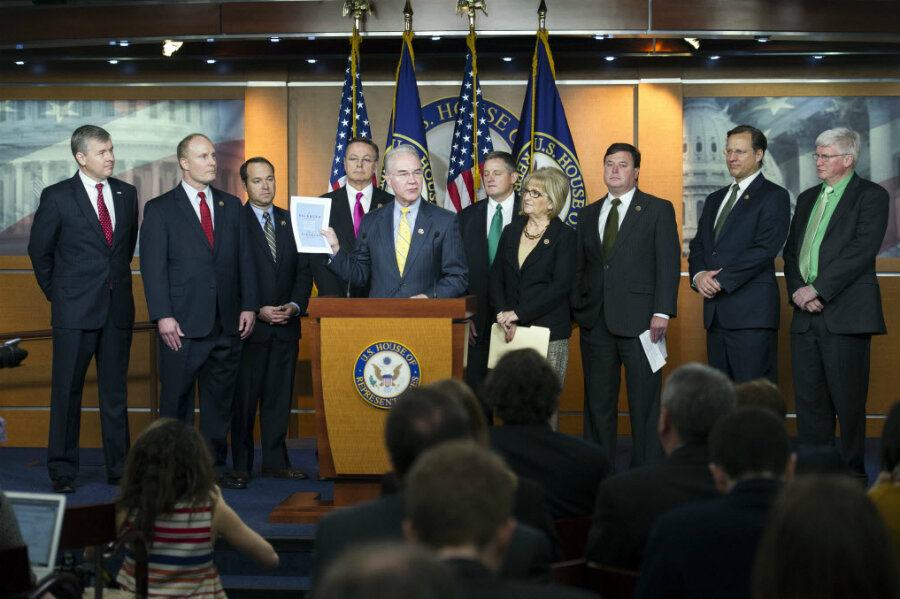GOP budget 'lacking policy details'? That's no reason to criticize it.
Loading...
Since the House budget resolution dropped on Tuesday, a lot of complaints have surfaced about its lack of detail. Lack of detail has some claiming it abandons Paul Ryan’s budget – even though it is remarkably similar – and many pundits and politicians lamenting the vague character of the House Republicans’ proposal.
There are a lot of reasons to criticize budgets. Lacking policy details isn’t one of them. The teeth of the budget are not in its policy. It is in the processes it establishes for legislation for the remainder of the fiscal year.
The practice of including policy statements in budget resolutions is actually a relatively new one. According to a Congressional Research Service report, since 1994 congressional budget resolutions have included an average of 22 declaratory statements. Between 1976 and 1993, congressional budget resolutions included only an average of three policy statements. The fact that the number of statements has increased as the parties polarized reinforces what everybody already knows: Budgets are political documents. They may express party goals but those statements do not bring Congress any closer to enacting those provisions.
The main reason budget resolutions are not policy documents is because the policy statements found in them are nonbinding. They have the same legal effect as nonbinding resolutions expressing the sense of Congress, the House, or the Senate. Vaunted legislation passed with the same nonbinding status has included welcoming India’s prime minister to the US, authorizing concerts by the National Symphony on Capitol grounds, expressing a sense of the Congress that the US should take a strong role in implementing decisions made at the Earth Summit, and thanking congressional colleagues for the manner in which they presided over the chamber. The policy statements in the budget resolutions may express a sense of the chamber or Congress, but they have no procedural or legal weight. It’s simply a statement.
The real teeth in budget resolutions are in the processes put in place when passed. First, budget resolutions set the topline spending and revenue numbers. Once passed by Congress, future legislation has to conform to those numbers. All appropriations bills, amendments, and committees must fit within the 302(a) number prescribed by the resolution.
Second, the budget committees can instruct other committees in Congress to find savings in existing law and, provided the committees meet the numbers, Congress could pass those bills with a simple majority in both chambers (i.e. filibuster-proof legislation). This process is known as reconciliation. The annual budget resolution outlines this annual process, detailing which committees can change government spending without worrying about a filibuster in the Senate. If you want to save money by tailoring Medicare and Medicaid, this is where you do it. For example, this year’s House budget gives instructions to 13 House committees to find a minimum of $4.75 billion in savings. If the committees meet the budget guidelines of the instructions, they can use reconciliation, avoid a filibuster, and pass the bill. However, how the committees find the savings is left to the committee of jurisdiction.
For example, the House proposed budget that dropped Tuesday instructed the Ways and Means Committee to find $1 billion in savings over the next 10 years. Despite the fact that that the Budget Committee included policy statements expressing an interest in changing Medicare and Medicaid, they cannot force Ways and Means to introduce policy doing that. If Ways and Means finds $1 billion of savings in tariffs, there is nothing the budget committees can do about that. That bill will still go through the filibuster-proof reconciliation process.
There are lots of reasons to debate the budget resolution. We can argue the merits of the House and Senate numbers and whether or not they actually accomplish what they claim to do. But “lacking policy detail” is not a great reason for criticism. That’s largely out of the budget committees’ hands. Regardless, the numbers and processes they put in place make it a very important document; just don’t expect it to have a lot of policy details.
Joshua Huder publishes his Rule 22 blog at http://rule22.wordpress.com.







